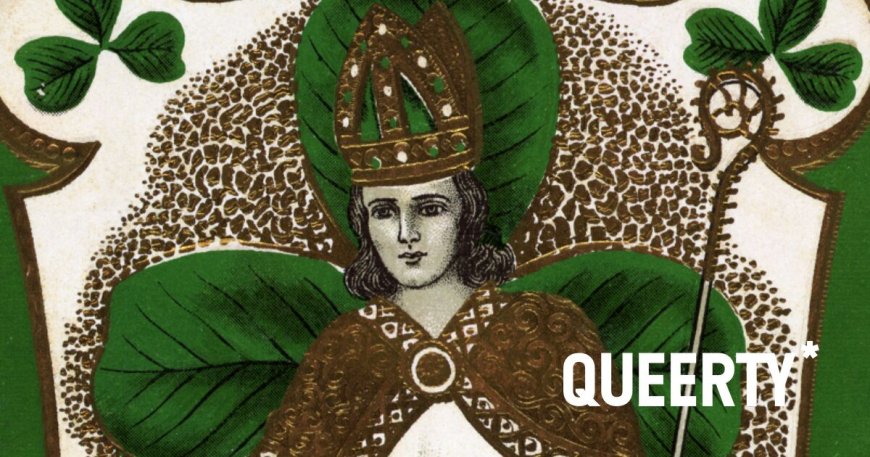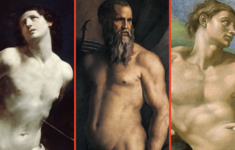St. Patrick was probably gay & had a thing for twinks
According to Brian Lacey, whose book 'Terrible Queer Creatures' explores Irish gay history, St. Patrick was an inveterate lover of boys.


St. Patrick’s Day is just around the corner, which means that queers everywhere will be… doing the same thing they do every other day of the year. 

St. Patrick’s Day has never been a very gay holiday, unlike Halloween or Oscar Sunday. Plus, queers have had their fair share of drama around the day, with organizers of the New York and Boston St. Patrick’s Day Parades historically mistreating our people.
That said, you might have something to wave in those organizers’ faces this year. According to Brian Lacey, whose 2015 book Terrible Queer Creatures explores Irish gay history, St. Patrick was an inveterate lover of boys.
How about we take this to the next level?
Subscribe to our newsletter for a refreshing cocktail (or mocktail) of LGBTQ+ entertainment and pop culture, served up with a side of eye-candy.
In the book, Lacey recounts an instance when St. Patrick doted upon the son of a man he had just converted to Christianity. No doubt, all the work of summoning God and promising eternal paradise must have worn Patrick out: Daddy needed a support twink.
But that’s not all! Patrick also gave the support twink a name. Disregarding the fact that you’re not supposed to name them (that’s how you get attached), the name was kind of cute – Benignus. Like the tumor!

Patrick and Benignus then became “lifelong companions.” Patrick even baptized him and made him the next bishop of Armagh, an illustrious position that probably meant something at the time.
Of course, that’s all just the secondhand account of a seventh century cleric named Tirechan, so take that with a grain of tasty red balloons. However, there’s also the not insignificant fact that Patrick was brought to Ireland as a Roman slave – and we all know what that means.
Of course, he famously escaped Ireland and only returned later to evangelize it, leading some to wonder how he got back. A well-placed boyfriend? A buttload of money that he already had, since he was most likely just an average guy who originally escaped Ireland to avoid a boring job as a tax collector? Guess we’ll never know!
In any case, the whole book by Lacey, which is appropriately inspired by a James Joyce quote, is worth a read. Notably, it paints a portrait of an erstwhile Ireland that very well could have been amenable to St. Patrick’s boy-cruising.
For instance, in the Gaelic Era, which lasted from prehistoric times to the 17th century, bards and poets freely gave themselves to handsome princes. Only later, after Catholicism took over the nation, did Irish people become so hostile to queer Irish folk like Oscar Wilde and Roger Casemant. (Even in 2009, a planned statue of Wilde in Worthing, Ireland – the town where he wrote The Importance of Being Earnest – incited vehement opposition.)

Patrick also wasn’t the only rumored gay saint.
There’s also Saint Sebastian, a third-century Christian martyr who has become something of a queer icon in the past century. Sebastian, who served as a Roman soldier under a pagan emperor, Diocletian, found himself sentenced to death by arrows for daring to be Christian.
However, Sebastian’s apparent sadomasochistic pleasure as he got pierced with multiple arrows, combined with his eight-pack and chiseled biceps, caused him to become a sex symbol among queer Renaissance men who later painted him. There was just something about his slightly parted lips and Sephora-friendly mug that made gay painters go, “Huh.”
In any case, there’s no shortage of queer myths surrounding saints in the long history of the Catholic Church; and plus, everything we know and love about St. Patrick is based on hearsay anyway. (The snakes thing? A lie.)
So what’s wrong with engaging in a bit of myth-making of our own? This year, if anyone runs their mouth about gays in the St. Patrick’s Day Parade and how that’s destroying the fabric of society, then just remind them of the queerness of the holiday they’re celebrating. After all, it’s not just about St. Patrick and the benign tumor that he loved.
It’s also about indiscriminately kissing people just because of something their shirt says, which is also how I’d describe an average summer at Fire Island.
So, go out and get your green on!
Related:
Why are all the dudes in Renaissance paintings so hot?
Seriously, early modern art is literally filled with hot dudes everywhere you turn.

 Mark
Mark 






